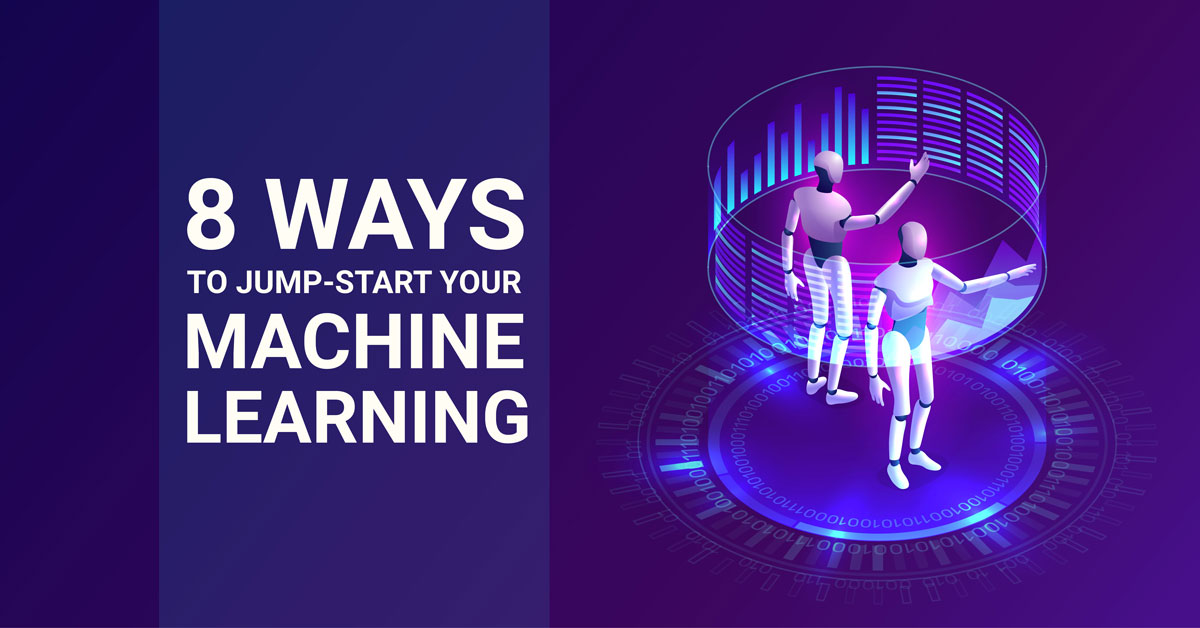8 Ways to Jump-Start Your Machine Learning

Sr. Software Development Engineer
Skilled Angular and .NET developer, team leader for a healthcare insurance company.
April 26, 2021
Machine Learning
Machine learning is the very latest big thing that is going to reign the world. It is the technique to scrutinize and consider data for mechanizing analytical model building. Machine Learning is actually an extended arm of Artificial Intelligence, which is developed from the point that without much human intervention systems can be instructed with data and thereby decisions can be made. Today, it has been changed from the past with latest computing technologies and therefore acquired fresh momentum.
For classification and prediction of data and outcomes respectively, there are 8 effective techniques for furthering and lifting off machine learning.

1. Take it off with experimental and probing data analysis
With experimental analysis of data, a combination of graphical and statistical techniques can be obtained. Histograms, box and whisker plots of individual variables, scatter charts of pairs of variables and plots of descriptive statistics and like are the most common methods for probing the data. Along with these methods, such an analysis of data includes principal component analysis and nonlinear dimensionality reduction with it. If the data is based on time, line charts are used with raw variables and statistics against time. This kind of data analysis is for sure philosophical in its approach.
2. Continue the race with clustering analysis
Clustering analysis is of course an unsupervised machine learning algorithm. In such an analysis data are grouped with similar data points. Even today, different clustering processes are still in run. These algorithms usually consider the metrics functions between the feature vectors of the observation points and then similar observations are put closer to each other. K-means is the generally used clustering technique and Lloyd's algorithm is the heuristic technique that is used to solve problems which efficient enough. Hierarchical cluster analysis, mixture models, or DBSCAN and like can also be considered in analyzing unsupervised data.
3. Semi-supervised machine earning for marking up the data
Cockroach Labs developed a modish, open-source storage engine from scratch, called Pebble. In 20.2, Pebble has replaced CockroachDB's former storage engine, ensuing in performance and stability improvements and giving Cockroach Labs more control over future database improvements.
4. Supportive datasets should be added up
CockroachDB assist many current data access tools, helping planners use their preferred programming language. 20.2 gives support for the Java tools Hibernate, MyBatis, Spring Data JPA, and Spring Data JDBC; and the Ruby tool Active Record.
5. Automated machine learning is the next thing to play its role
CockroachDB is already low-touch and requires minimal operations, and 20.2 lets teams save even more time with scheduled automated backups, faster data imports, and more options for bulk data imports.
6. Purposefully build the transfer learning using trained models
CockroachDB's monitoring UI displays key metrics that are critical for troubleshooting. 20.2 adds two new pages to assist developers introspect and apprehend query performance: a SQL transactions page and database sessions page.
7. Make the effort to try out deep enforcement learning code and models from model zoo
CockroachDB 20.2 adds two new pages to help developers introspect and understand query performance:
8. Finally, enhance the hyper-parameters of the model
The Sessions page of the DB Console provides details of all open sessions in the cluster. See live database sessions, and cancel them easily from the DB Console. For a given session, you can see whether there's a live transaction, which statements are currently running, and how long sessions have been running.
Conclusion
The machine learning and model building process can be kicked off with experimental and exploratory analysis of data. After which the process should be carried on with clustering analysis and then semi-supervised learning should be employed for better understanding of the data and its features. After that complementary datasets should be put on followed by automated machine learning for testing out many models really fast. Behind that transfer learning should be tried with trained models and before trying training and designing process of your network from abrade use model zoo. In the end enhance the machine learning process by hyper-parameter tuning. The produced model should be monitored and tracked. For different data different type of models can be used and one can even upgrade and retrain the already made model.
Machine learning is feasible by all means being affordable and with its powerful processing, data storage and boundless quantity of data. Data can be analyzed and delivered fast with robust and better machine learning. The process is evolving quickly and it is getting extended to illimitable possibilities.













